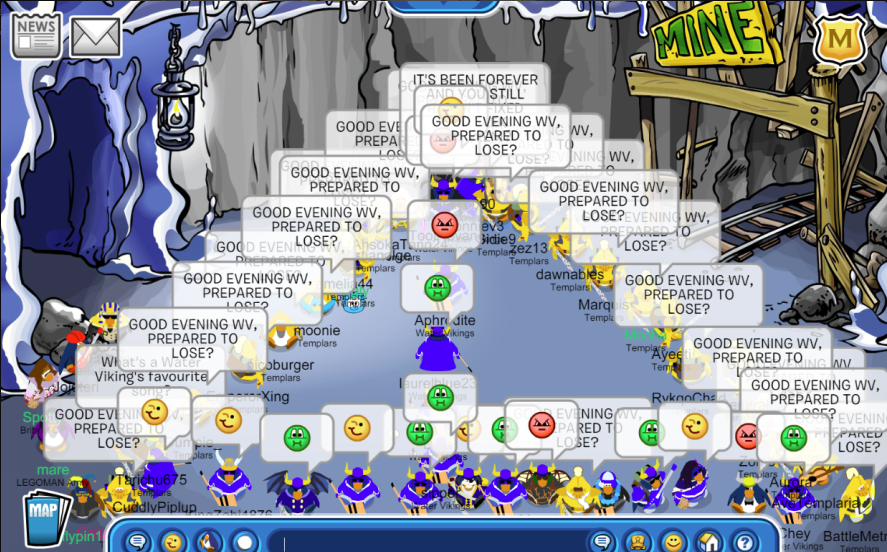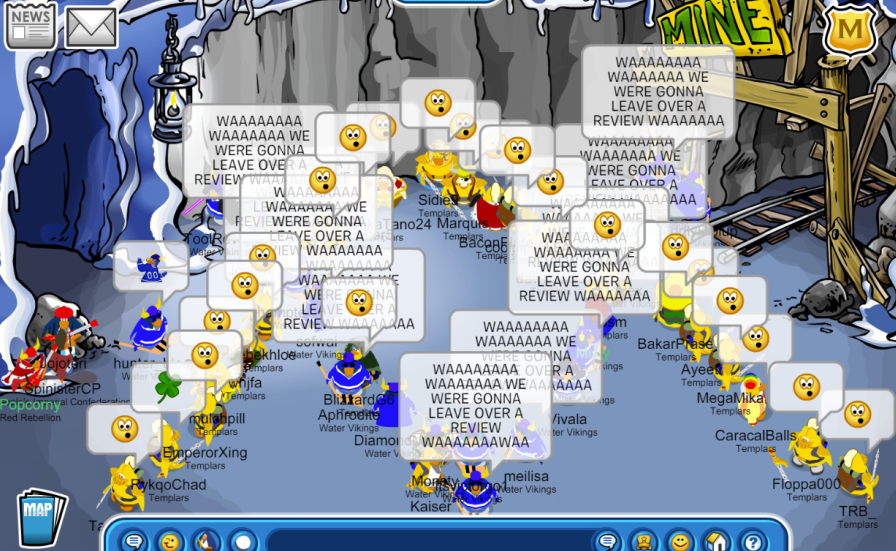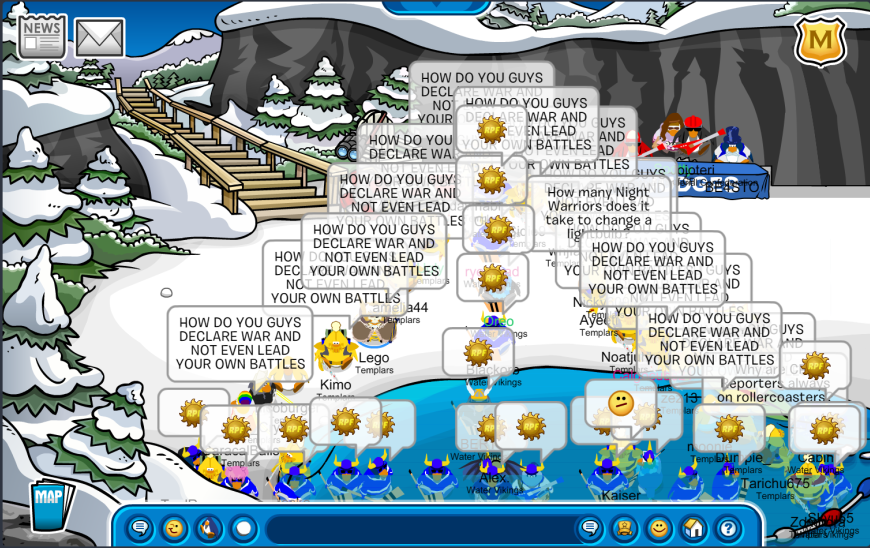Over a week ago, the Water Vikings issued a declaration of war against the Templars. Since then, fifteen battles have been hard fought between the two armies, with the Knights holding a favorable lead. However, an end to this war does not appear to be on the horizon.

Designed by Disha
On the 7th of April, war erupted between the Water Vikings and the Templars. Issuing a formal declaration against the Knights, the Vikings cited various reasons for this war, including conflicting history and the Templars’ no-show of the New Year Bonanza tournament. So far, fifteen battles have been fought, with the Templars holding a score lead of eleven to four. Fifteen wins from either army are required for the conflict to conclude. Though the Templars hold a favorable lead, the Vikings show no sign of backing down anytime soon.
Battle One – Water Vikings’ Invasion of Antioch
The first battle between the two armies took place during WV’s invasion of Antioch. Room one witnessed close sizes between the Vikings and Knights, with the judges noting the Templars moving at a faster rate and using a healthy variety of word and emote tactics, resulting in TCP winning room one. Room two saw both armies sharing control of the room, with the Knights and Vikings displaying equal performance at different points, leading to room two being declared a tie. The Vikings picked up the pace in room three, controlling the space through their speed, cover, and choice of formations. With a tie and each army winning a room, the battle went into overtime. Though having a smaller size than the Templars, the Vikings used formations that made them appear larger. Throughout the overtime room, WV displayed cleaner forms and faster tactics, leading to their successful invasion of Antioch.

Battle Two – Templars’ Invasion of Southern Lights
In another closely contested battle, the Templars moved to invade Southern Lights. In room one, there were near equal sizes between the Knights and the Vikings, with each army demonstrating slightly neater formations at different moments. Both sides countered each other effectively, exhibiting equal speed, forms, and tactics, resulting in a tie for room one. Room two saw similar dynamics of room one, with both armies displaying comparable performances. Each army managed to dominate the room at different points, resulting in room two being declared a tie as well. However, in room three, the Templars intensified their efforts, seizing control of the battlefield through their speed, size, and formations. This led to the Templars winning room three and successfully invading Southern Lights.

Battle Three – Templars’ Invasion of Slippers
In battle three, the Templars and Vikings logged on for the Battle of Slippers. In room one, the Templars retained control through their coverage, formations, and tactics, securing victory in the first room. Room two witnessed the Vikings picking up the pace, demonstrating performance equal to that of the Knights. As both armies performed similarly, room two was deemed a tie. Moving to room three, the Templars entered first and swiftly took command of the battlefield. While sizes were comparable, TCP was noted for their swiftness with bombs, formations, and tactics, resulting in their victory in room three. Consequently, the Templars successfully invaded Slippers.

Battle Four – Templars’ Invasion of Outback
The Templars’ Invasion of Outback resulted in a clean sweep for the Knights. TCP held a consistent size advantage throughout all three rooms and utilized it effectively. The Water Vikings were noted to have performed better bombs, however, in all other areas, the Templars retained control of the battlefield. Consequently, the Templars successfully invaded Outback.

Battle Five – Templars’ Invasion of Antioch
The fifth battle of the war saw the Templars’ invasion of Antioch. Though the Water Vikings did an excellent job in defending themselves against the Templars’ size advantage of 10 penguins, ultimately TCP won all three rooms due to their dominance, tactics, size, and coverage.

Battle Six – Water Vikings’ Invasion of Paris
The Water Vikings’ Invasion of Paris was yet another close battle. Room one witnessed close sizes between both TCP and WV. The Vikings utilized formations to cover the Templars, while the Knights demonstrated speed, equalling out the playing field. Room one was deemed a tie. Room two saw a similar outcome, with both armies showing strong performances in different areas, leading to another tie. During room three, the Vikings utilized their slight size advantage, dominating the battlefield. Their formations were noted to be neater, with their speed faster than their opponents. Due to this, the Vikings won room three and successfully invaded Paris.

Battle Seven – Templars’ Invasion of Husky
Templars’ Invasion of Husky was yet another close battle. Room one saw TCP with a slight size advantage, however the Water Vikings utilized formations that allowed them to appear larger. The Vikings were able to successfully defend themselves against TCP’s rakes and bombs, covering the Knights at multiple points throughout the room. Due to their speed, choice of forms, and coverage, the Water Vikings won room one. Both rooms two and three saw dominance switching between the Vikings and Knights at different points. Neither army were strong enough to take the rooms, so they were both deemed a tie. Due to this, the Water Vikings successfully defended themselves against the Templars.

Battle Eight – Water Vikings’ Invasion of Acre
Battle eight saw the Templars successfully defending themselves against the Water Vikings. Room one witnessed a significant TCP size advantage, with 29 troops to WV’s 18. The Knights utilized their size advantage, showcasing clean forms and speedy tactics, leading to their victory in room one. Room two witnessed pros and cons from both armies, with each covering and dominating at certain points, leading to a tie. Room three was similar to room one, with the Crusaders utilizing their size advantage to create clean forms. Though WV showed off a really neat formation towards the end of the battle, it wasn’t enough to take the room. Due to this, the Templars successfully defended themselves against the Water Vikings.
Battle Nine – Templars’ Invasion of Paris
During the Templars’ next invasion of the Water Vikings, they achieved a size of 24 penguins. Though Spotty reached a maximum size of 34 judges, due to the Water Vikings not showing up, the Templars successfully invaded Paris.

Battle Ten – Water Vikings’ Invasion of Alexandria
The tenth battle of the war saw another Water Vikings invasion. Sizes during the first room were near even, as both armies maintained control of the room at certain points. Their speed and formations were consistently the same throughout the room, leading to room one being declared a tie. During rooms two and three, the Templars had a larger size and a better performance. Though the Water Vikings appeared to not make the win easy for them, ultimately their invasion of Alexandria was unsuccessful.

Battle Eleven – Templars’ Invasion of Subzero
The battle for Subzero began with the Templars achieving a maximum size of twenty penguins. Due to the Water Vikings not showing up, the judges Templars were deemed the winner of the battle.

Battle Twelve – Water Vikings’ Invasion of Rome
Battle twelve witnessed another Water Vikings invasion of Templars. Rooms one and two saw the Templars showing off their larger size, along with neater formations and faster tactics. Both rooms one and two were ruled a TCP victory. Throughout room three, both the Knights and Vikings had their ups and downs, leveling out the playing field and resulting in a tie. The Templars successfully defended themselves against the Water Vikings.

Battle Thirteen – Templars’ Invasion of Icicle
The Templars achieved a size of 22 during their invasion of Icicle. In a very close battle, the Clown Rebellion put up a strong fight against the Knights, however, unfortunately, they couldn’t juggle a victory. Their presence during the battle was a nice jester, however the win went to the Knights due to the Water Vikings not showing up.

Battle Fourteen – Templars’ Invasion of Husky
In a celebratory battle for Queen Elsa’s birthday, the Templars displayed a maximum size of 16 penguins. Due to the Water Vikings not showing up, the invasion was ruled a Templars victory.

Battle Fifteen – Water Vikings’ Invasion of Antioch
The fifteenth battle of the war was yet another close call. Both rooms one and two saw the Knights and Vikings dominating at different points throughout the battle. Sizes were close as they switched control of coverage, speed, and formations. As a result, rooms one and two were ruled a tie. Throughout room three, the Vikings displayed a strong choice of formations and were noted to be speedier and neater. As a result, the Vikings won room three and successfully invaded the Templars.

It has been over a week of battles between the Templars and Water Vikings, however neither army appears to be giving up anytime soon. Though the Water Vikings have no-showed a significant amount of AUSIA battles, they have been successful in many of the battles they have attended. Score-wise, the Templars are winning the war so far, however, the most recent invasion of Antioch proves that the Vikings are capable of victory. While the outcome of this war is yet to be determined, one thing is for certain, both armies have proven to be a strong match against each other!